Effective Methods to Unclog a Hair-Blocked Tub Drain
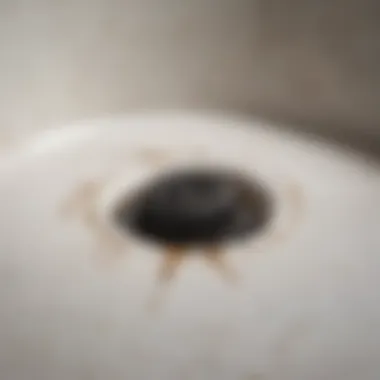
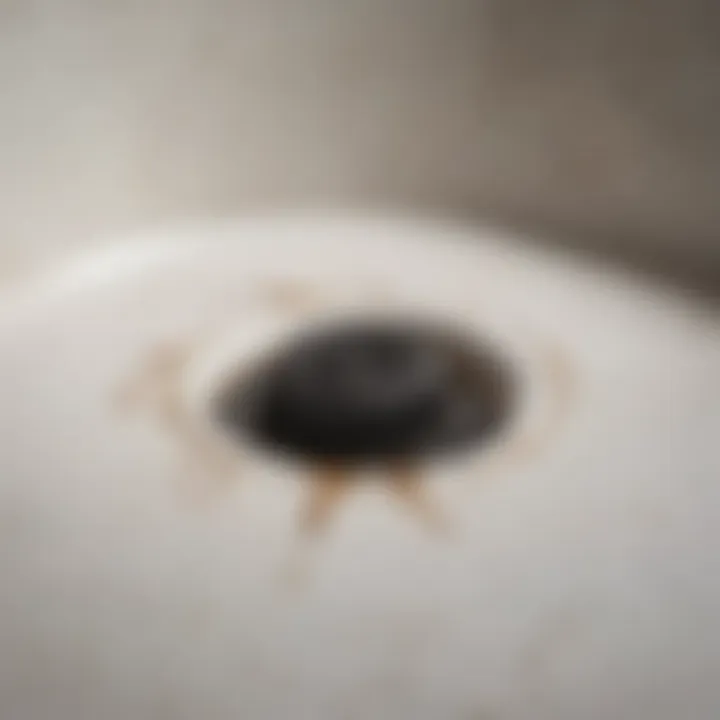
Intro
Blocked drains require immediate attention to avoid more significant plumbing issues. One of the most common culprits is hair, which can accumulate over time and create stubborn clogs in tub drains. Understanding effective methods to deal with this problem is essential for maintaining a functional drainage system at home.
This section aims to provide practical insights into why hair clogs occur, how to prevent them, and the various methods to unclog a tub drain. From preventive strategies to DIY solutions, this guide covers everything needed to ensure that your drains remain clear and efficient.
Understanding Hair Clogs
Hair does not dissolve in water, making it a persistent issue in drains. When combined with soap residue, grease, and other debris, hair forms a tangled mess that obstructs water flow. Often, the buildup of hair is gradual, leading to a minor annoyance that becomes a serious obstruction over time.
Key Factors Contributing to Hair Clogs
- Volume of Hair: Longer hair tends to tangle more easily.
- Drain Design: Some tub designs may trap hair more than others.
- Frequency of Use: High traffic areas are more prone to clogs.
Recognizing these factors can aid in developing effective strategies for prevention and unclogging.
Preventative Strategies
Taking steps to prevent hair from entering the drain is far better than having to unclog it later. Here are indicated methods to consider:
- Install a Drain Strainer: A simple and inexpensive drain strainer can catch hair before it enters the plumbing system.
- Regular Cleaning: Periodically remove visible hair from the drain and clean the strainer to reduce buildup.
- Educate Household Members: Ensure that everyone in the home understands the importance of maintaining the clean drain.
Tools and Techniques for Unclogging
When prevention fails, having the right tools can make unclogging easier. Consider using:
- Plumber's Snake: A long, flexible tool that can reach deep into the drain to dislodge hair clogs.
- Wet/Dry Vacuum: Effective at sucking out hair without pushing it further down the drain.
- Chemical Drain Cleaners: Should be used carefully, as they can damage pipes.
DIY Methods
- Baking Soda and Vinegar: Pouring baking soda followed by vinegar can help break down hair clogs naturally. Let it sit for a while, then flush with hot water.
- Boiling Water: In many cases, simply flushing the drain with boiling water can dislodge hair and residue.
The End
Regular maintenance and prompt action are the keys to avoiding hair clogs in tub drains. Implementing preventive strategies and employing effective methods will lead to a more efficient home drainage system. By understanding the nature of hair-related clogs and utilizing the right tools, one can keep drains functioning properly.
Prelude
Dealing with a clogged tub drain is a common household issue, often caused by hair accumulation. Hair clogs can lead to slow drainage or even complete blockages, causing frustration and potential damage to plumbing systems. This article will delve into various effective methods to address hair-related drain blockages. Understanding this issue is essential for maintaining a functional bathroom and preventing costly repairs.
In addition to providing solutions, we will discuss preventive measures and tools that can minimize the occurrence of such problems. Readers will benefit from practical advice that is easy to implement and may save both time and money.
Knowing how to handle hair clogs effectively will empower homeowners to tackle this issue as it arises, reducing reliance on professional plumbing services for minor problems.
Overall, an effective strategy for unclogging a tub drain ensures smoother household operations and exhibits proper maintenance of plumbing systems.
Understanding Hair Clogs
Hair clogs are a common problem in household drainage systems, particularly in bathtubs. Understanding hair clogs is important for several reasons. First, it helps homeowners identify the source of recurring drainage issues. The presence of hair in drains can lead to significant water flow reduction, causing frustration and potential damage. Second, by understanding the nature of these clogs, one can implement preventive measures that save time and money. Finally, knowledge about the mechanics of hair clogs can guide homeowners in choosing the right tools and methods when faced with a clogged drain.
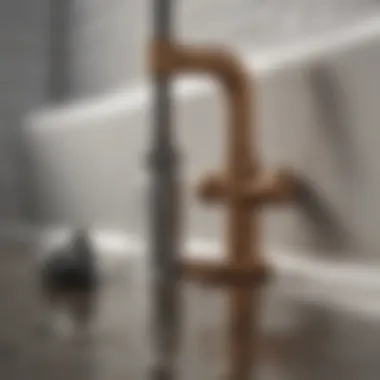
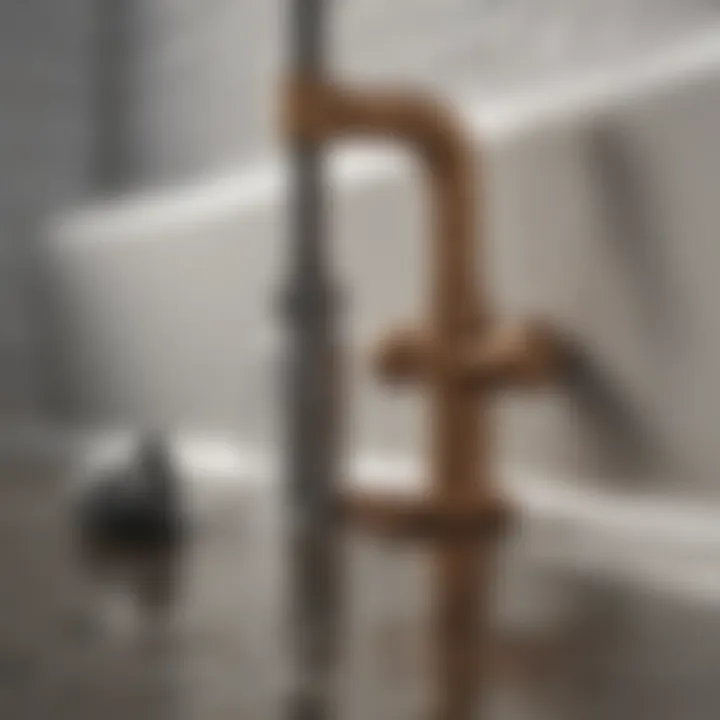
What Causes Hair to Clog Drains?
Hair clogs primarily form due to the accumulation of hair strands in the drain over time. When hair washes down the tub drain, it often gets trapped in the drain's curves or in materials like soap or grease. This creates a mat that gradually builds up, making it difficult for water to pass through. In addition, factors such as the frequency of use of the bathtub, the type of hair, and the drain's design can affect how quickly clogs form. Understanding the primary culprits is crucial for developing effective strategies to prevent and remove hair clogs from drains.
Impact on Plumbing Systems
Hair clogs can have several negative impacts on plumbing systems. Firstly, they impede water flow, which can result in slow drainage and, ultimately, overflows. This can create unsightly messes and lead to water damage in bathrooms. Secondly, hair clogs can increase pressure within the plumbing pipes. This heightened pressure may weaken pipes over time, leading to leaks or breakage. In extreme cases, recurring clogs may necessitate more extensive plumbing work, resulting in costly repairs. Learning about these potential issues underlines the importance of tackling hair clogs promptly and effectively.
Preventive Measures
Preventive measures are crucial in minimizing the frequency of hair clogs in tub drains. Understanding how to effectively prevent these clogs saves time, effort, and the potential expense of more severe plumbing issues later. By adopting a proactive maintenance routine, you can extend the lifespan of your plumbing system and maintain a more pleasant shower experience. This section discusses essential techniques for regular cleaning and the importance of installing drain strainers.
Regular Cleaning Techniques
Regular cleaning is one of the most effective methods to prevent hair clogs. It involves periodically removing hair and debris that accumulates over time. Daily or weekly cleaning can significantly reduce the buildup of hair and soap scum. Here are some approaches:
- Visual Inspection: Regularly inspect your drain for visible hair or material that might be accumulating. If you notice a buildup, act quickly.
- Hot Water Flush: Running hot water down the drain can help dissolve soap residue and push debris further down. This technique is simple yet effective.
- Routine Deep Cleaning: At least once a month, clean the drain opening using a small brush or a cotton cloth. This ensures that any trapped hair is removed before it can cause a blockage.
Maintaining this routine creates fewer problems down the line, ensuring that your drains remain clear and flow properly.
Use of Drain Strainers
Using drain strainers is a simple and effective preventive measure. These tools catch hair and larger debris before they can enter the drain. Installing a drain strainer can be beneficial for long-term maintenance. Consider the following points:
- Types of Strainers: Strainers come in various designs, such as metal mesh or silicone. Choose a strainer that fits securely in your drain without obstructing water flow.
- Cleaning the Strainer: After using the tub, empty the strainer regularly. Clean it thoroughly to prevent any buildup, which could lead to odors or further clogs.
"An ounce of prevention is worth a pound of cure." Regular use of drain strainers and cleaning techniques not only extends the life of your plumbing but also enhances the overall hygiene of your bathing area.
- Cost-Efficient: Strainers are generally affordable and easy to install. Their low cost makes them an attractive solution for proactive drain maintenance.
By integrating these preventive measures into your regular cleaning routine, you can effectively reduce the chances of facing a clogged tub drain in the future.
DIY Solutions to Unclog a Hairy Drain
Unclogging a hair-filled drain may seem daunting, but DIY solutions are often effective and economical. These methods are beneficial as they use commonly available household items. Moreover, employing DIY techniques allows homeowners to tackle the issue without the immediate need for professional intervention, saving both time and money. The key to effective DIY solutions is to choose the right method based on the severity of the clog. Understanding each technique can enable readers to choose the most suitable and efficient approach for their specific situation.
Boiling Water Method
The boiling water method is very straightforward. This technique involves pouring boiling water down the drain in stages. It is effective because hot water can dissolve soap buildup affecting hair and other materials. Hot water can loosen hair clumps and allow them to wash away. To execute the method, boil a kettle or large pot of water and pour it slowly down the drain. Perform this in several stages, allowing each batch some time to work before adding the next. If the clog persists, other more involved methods might be necessary.
Baking Soda and Vinegar
This method employs basic chemistry. Combining baking soda with vinegar creates a fizzing reaction that can dislodge clogs. To use this method, first pour half a cup of baking soda into the drain. Follow with half a cup of vinegar. You will notice bubbling and fizzing as the two components react. Allow this mixture to sit for about 30 minutes. Finally, flush the drain with hot water to clear any remnants. This method is environmentally friendly and does not involve harsh chemicals.
Manual Removal Techniques
Manual removal techniques often offer a direct solution to hair clogs. In some cases, it may involve using simple tools available at home. Here are a few effective methods:
Using a Hair Snake
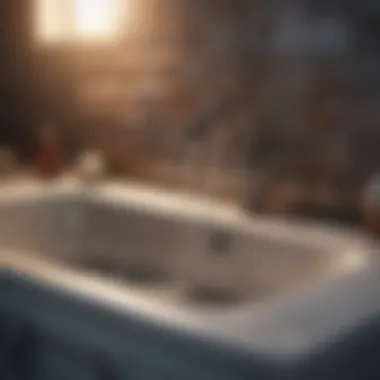
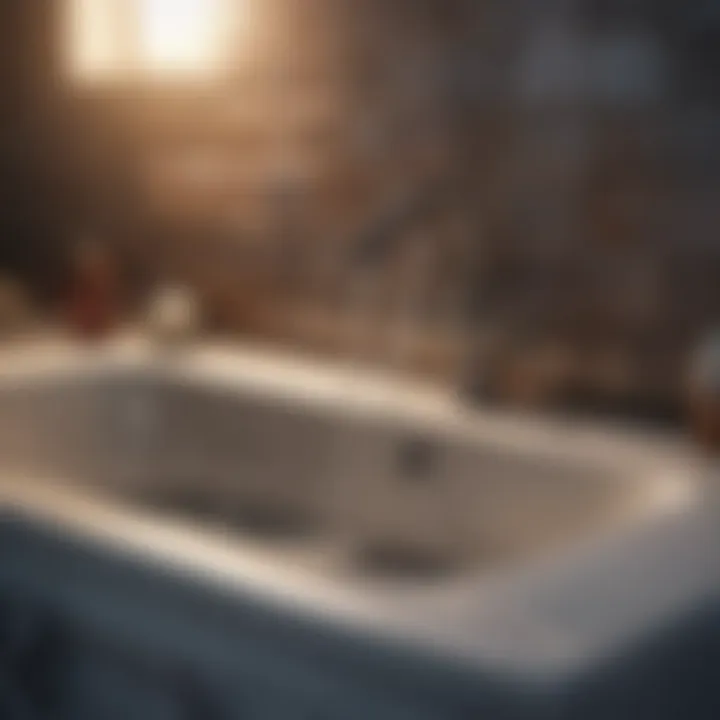
A hair snake is a flexible, rod-like tool designed to remove hair and debris from drains. Its key characteristic is the ability to navigate around bends and curves within the pipe. Its design allows it to grip hair effectively. Many people find this method a useful choice for clearing hair clogs because it does not rely on chemicals. When using a hair snake, simply insert it into the drain and twist or pull it out, ensuring you remove any hair it catches. One of its advantages is ease of use, but it requires patience and may not always remove all debris.
Using a Wire Hanger
A wire hanger is an accessible alternative to a commercial hair snake. Its flexibility is both a strength and a weakness. While it can maneuver within the pipe, it does not have the same gripping capabilities as a hair snake. Bend the hanger into a small hook shape at one end. Then, gently push it into the drain and try to catch and pull out any hair clumps. This method is cost-effective, but it may require more effort compared to using professional tools, and it risks damaging the drain if mishandled.
Using Gloves and a Bucket
When you suspect a serious clog, using gloves and a bucket can be an effective manual approach. This method allows you to inspect the drain directly. After removing the drain cover, wear gloves to protect your hands. Use a bucket to catch any water that may spill out. Reach in to pull out any visible clumps of hair and other debris. This method is beneficial as it provides direct access to the problem area. However, it can be messy and may require some cleaning up afterward.
Advanced Tools for Clog Removal
Dealing with a clogged drain can be frustrating, especially when hair is involved. While DIY methods often provide satisfactory results, advanced tools are sometimes necessary for tougher clogs. Understanding these tools is crucial for homeowners, renters, and property managers aiming to maintain a functional drainage system.
These tools not only expedite the unclogging process but also minimize damage to the plumbing. Moreover, they can be more effective than many home remedies. Knowing when and how to use them can save time and prevent costly repairs down the line.
Plumbing Augers
A plumbing auger, also known as a drain snake, is a valuable tool for deep clogs in tub drains. It consists of a flexible wire with a reinforced corkscrew end designed to break apart and remove blockages. When using a plumbing auger:
- Insertion: Feed the auger into the drain until you hit resistance.
- Rotation: Turn the handle to break through the clog. This action pulls or pushes the blockage further down the pipe.
- Retrieval: Once you’ve broken through, carefully pull the auger back to remove debris.
This tool is especially effective for clogs that cannot be reached by just using boiling water or other homemade solutions. It can be used for hair and other debris, making it versatile. However, care must be taken, as excessive force can damage the pipes.
Wet/Dry Vacuum
A wet/dry vacuum, also often called a shop vacuum, is an excellent option for unclogging drains clogged with hair. This versatile tool can either suck up water or liquids or push air out for clearing a drain.
To use a wet/dry vacuum for a tub drain:
- Set Up: Ensure the vacuum is set to the wet mode. Attach the appropriate hose.
- Seal: Create a seal at the drain entrance using the vacuum hose. Securing it tightly helps maximize suction.
- Vacuum: Turn on the vacuum. It will create suction that can pull out hair and debris stuck in the drain.
Wet/dry vacuums are particularly beneficial for removing a significant amount of water from the tub while dislodging clogs.
Using these advanced tools can enhance drain maintenance. Knowing when to resort to these options can determine the effectiveness of the unclogging effort.
Chemical Drain Cleaners
Chemical drain cleaners are often the first choice for many when faced with a clogged tub drain. These products are designed to dissolve or dislodge blockages, particularly hair, grease, and soap scum. The importance of chemical drain cleaners lies in their ability to provide a quick solution without requiring extensive labor. They can be especially beneficial for individuals who may not have the tools or experience for manual unclogging methods. However, using these cleaners comes with necessary precautions that must be considered.
Types of Chemical Cleaners
There are several types of chemical drain cleaners available in the market. Understanding these options can help users select the most effective one for their needs.
- Acidic Cleaners: These are potent solutions that use sulfuric or hydrochloric acid to break down clogs. They are powerful but can damage pipes if used excessively.
- Alkaline Cleaners: These typically contain sodium hydroxide and are effective against grease and hair. They work by creating a chemical reaction that generates heat to dissolve blockages.
- Oxidizing Cleaners: Products like hydrogen peroxide fall into this category. They help in breaking down organic material within the pipes without causing damage to plumbing.
"Choose the right type of chemical cleaner based on the nature of the clog to ensure effectiveness and minimize risks."
When selecting a cleaner, consider the type of material the clog is primarily made of. Hair and soap residue respond better to alkaline cleaners, whereas acidic cleaners might be more effective on mineral-based clogs.
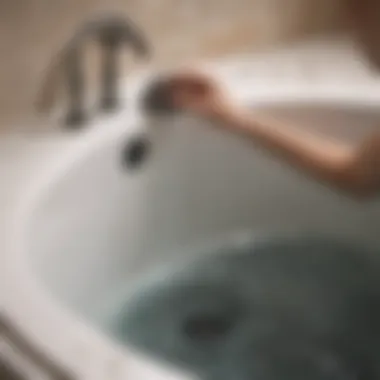
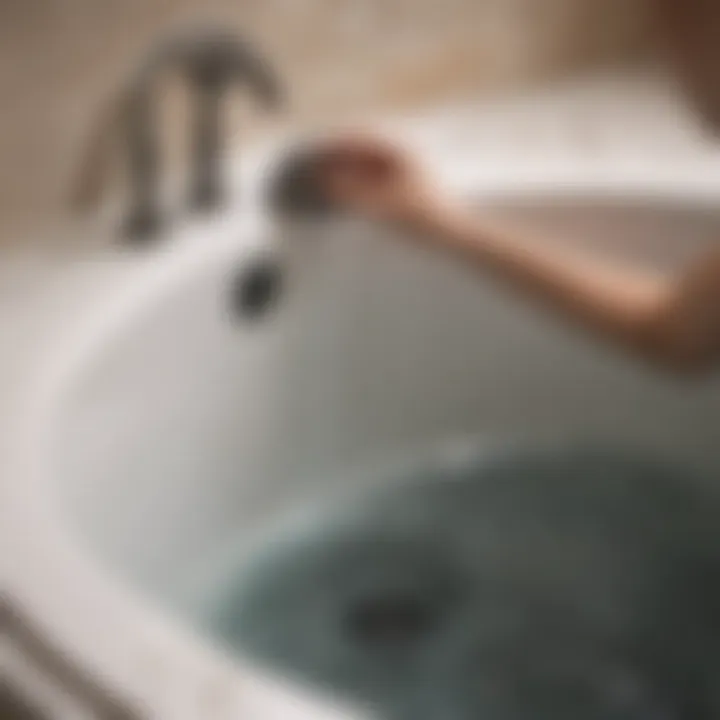
Cautions and Considerations
While chemical drain cleaners can be effective, certain cautions must be observed:
- Pipe Material: Some chemicals can corrode pipes made of plastic or old metal. Always check if the cleaner is safe for your plumbing.
- Safety Gear: It's crucial to wear gloves and protective eyewear when using these cleaners, as they can cause severe skin and eye irritation.
- Ventilation: Ensure the area is well-ventilated when using chemical cleaners to avoid inhaling potentially harmful fumes.
- Follow Instructions: Users must adhere strictly to the manufacturer's instructions regarding the amount and application process.
- Avoid Mixing: Different chemicals can create dangerous reactions. Never combine various drain cleaners.
When to Call a Professional
Determining when to engage a professional plumber can be a crucial aspect of effectively managing a clogged tub drain. While many minor clogs can be resolved with DIY methods or basic tools, there are circumstances when professional intervention is necessary. Understanding these situations can save time, money, and prevent further damage to plumbing systems.
The key reasons for calling a professional include recurring clogs, more serious backups such as sewage coming back through drains, or if you can’t access or clear materials causing the blockage. Getting help from professional plumbers not only aids in removing blockages effectively but also allows for proper inspection of the entire drainage system. They possess specialized tools such as hydro-jetters or drain cameras, which can diagnose the problem beyond what standard tools can achieve.
Signs You Need Help
Recognizing the signs that indicate the need for professional services is essential. Here are several indicators:
- Frequent backups: If the tub frequently clogs again days or weeks after clearing, it's a signal of a deeper issue.
- Slow draining: A tub that drains slower than usual may require professional tools for resolution.
- Unusual smells: If foul odors persist, it might suggest a plumbing issue that needs immediate intervention.
- Mold or mildew: Growth in or around drain areas can indicate prolonged dampness potentially caused by a serious clog.
- Multiple fixtures affected: If several drains in your home back up at the same time, it might indicate a more systemic blockage.
It is wise to observe these symptoms and act promptly. Delay can escalate the problem, resulting in higher repair costs.
Choosing a Plumbing Service
Selecting the right plumbing service is crucial for resolving clogged drains efficiently. When searching for a plumbing professional, consider the following tips:
- Look for credentials: Ensure the plumber is licensed and insured. This protects you in case of accidents or damage.
- Read reviews: Reviews on platforms like Reddit or Facebook can provide insights about the service quality.
- Check experience: Choose plumbers who have specific experience with drain cleaning and related plumbing issues.
- Get estimates: Request estimates from different plumbers to compare prices and services offered. Ensure these estimates include potential additional costs.
- Ask about guarantees: Inquire if they offer any guarantees for their service. This can help if issues arise shortly after the work is done.
Choosing the right plumbing service not only leads to quicker and easier solutions to your clog issues but also enhances the overall health of your plumbing system.
Maintaining Drain Health
Maintaining drain health is crucial for the longevity and efficiency of your plumbing system. A well-functioning drainage system prevents undesirable scenarios from happening in the home. Not only does it prevent unpleasant smells, but it also avoids costly repairs associated with severe blockages or even water damage. Routine care minimizes the risks of hair and other debris accumulating to form stubborn clogs. Regular attention can save both time and money in the long run while ensuring the plumbing remains functional.
Establishing a Routine
To cultivate good habits, it is important to establish a maintenance routine for your drains. Aim to clean your tub drains at least once a month. This will keep hair, soap residue, and other debris at bay. The process can involve simple tasks. For example, remove visible hair and debris from the drain cover, or use a drain snake to extract material lurking below the surface.
In addition to regular cleaning, consider using natural cleaning solutions like vinegar or baking soda every few months. These ingredients can help break down buildup and keep your drains smelling fresh.
Establishing this routine not only keeps your drains clear but also promotes awareness about the importance of maintenance among household members.
Educating Household Members
It is important that everyone in the household understands how to maintain drain health. Start by sharing information on what not to put down the drain. Educating household members can significantly reduce instances of clogs caused by hair and other debris. Create a simple guideline outlining the dos and don’ts for the bathroom. For instance, hair should always be disposed of in the trash, not rinsed down the drain.
A cooperative approach fosters a sense of responsibility among all members. Encourage regular checks of the drain, particularly after baths or showers, to remove hair or anything caught in the drain cover. This small effort goes a long way in prolonging the life and function of your tub drain.
Ending
The conclusion of this article underscores the significance of effectively managing a tub drain that is often blocked by hair. Given the frequency and commonality of hair clogs, understanding the methods presented herein is essential for maintaining a functional and hygienic plumbing system in any home.
One of the key elements discussed is the need for preventive measures. Implementing regular cleaning techniques and using drain strainers can significantly reduce the likelihood of hair build-up. Such simple steps might seem negligible at first, but over time, they serve as an effective barrier against the inconveniences of clogged drains.
Additionally, various DIY and advanced methods to unclog drains provide homeowners with practical solutions that do not always require a professional plumber. For individuals comfortable with hands-on tasks, methods like using boiling water, baking soda and vinegar, or plumbing augers can save time and money. However, knowledge of when to seek professional help is also vital. Recognizing the symptoms that suggest a deeper issue could prevent more extensive damage to plumbing systems.
By synthesizing the information presented, it becomes clear that addressing hair clogs is a manageable task. With the right resources and knowledge, homeowners can ensure their drainage systems remain clear and efficient, thus avoiding unnecessary frustration and expense.



